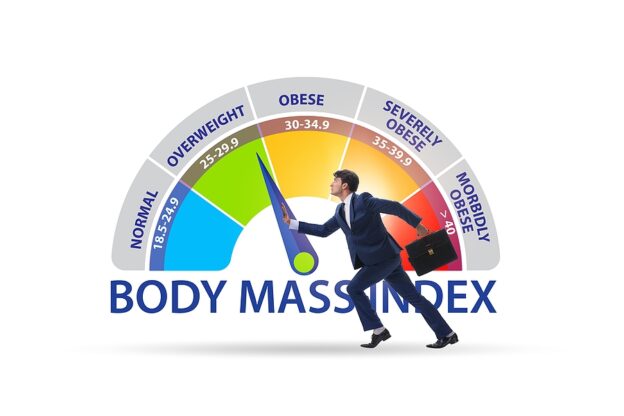By David Blyweiss, M.D., Advanced Natural Wellness
March 9, 2022
People often worry about their body mass index when they shouldn’t.
Say you’re five feet, eight inches tall and weigh 200 pounds. You’ve got a BMI of 30.4, which says you’re obese.
If you’re active and well-muscled, you probably aren’t anywhere near obese. But if you’re a couch potato who is out of shape and carrying around a lot of excess fat, well, then the BMI got it right for you.
It works just the opposite, too.
This time, let’s put you at five feet, eight inches tall with a weight of 150. Congrats! You’re at a healthy 22.8 BMI. But are you really? Or do you fall into this category because you aren’t getting the nutrition you need and your muscles are wasting away because of inactivity?
Open your arteries, improve blood flow for a new health miracle...
Did you know your circulatory system has over 60,000 miles of arteries, veins and other blood vessels, if stretched end to end?
But as you age, your blood vessels undergo changes, which may cause them to stiffen, thicken and get clogged.
GOOD NEWS! Doctors have now identified a “Miracle Molecule” inside your arteries that helps OPEN your arteries and IMPROVE blood flow.
It’s what Dr. Valentin Fuster calls it, "One of the most important discoveries in the history of cardiovascular medicine."To you, that means...
- Healthy blood pressure
- Sharper mind and memory
- Skyrocketing energy and muscular strength
- Increased pleasure and passion in the bedroom
- Improved circulation to every cell and organ in your body
Go here to discover a new natural way to significantly boost the levels of this miracle molecule in YOUR body NOW!
What I find is that the BMI can be useful when you’re looking at a very large dataset. But it starts to fall apart when you try to individualize it.
For example, when studies actually looked at health biomarkers in people who are obese based on their BMI, they found that about 30% of them were completely healthy. Their blood pressure, triglycerides, cholesterol, glucose, insulin resistance and C-reactive protein data were all fine. And nearly 50% of those whose BMIs categorized them as obese were healthy, too.
At the same time, about 30% of people with “healthy” BMIs actually had poor markers of health.
If I had to hazard a guess, I’d say these are the people who defy the nature of the body mass index – which only performs a rough height/weight calculation without taking anything else into account. So judging their health and weight by BMI is misleading.
BMI Isn’t the Best Marker of Weight and Health
BMI alone should never be a used as the sole marker of your health or weight.
If you have a fit and muscular build, the BMI can clock you in as overweight or obese. Conversely, if you’ve lost muscle and gained belly fat with age, you may fall well within normal ranges on the BMI scale, but still be very unhealthy.
The World's Quickest Solution for Ending Prostate and Urinary Misery
This has recently been revealed to be one of the only real breakthroughs in prostate health.
The seeds of a strange fruit (sometimes called "Chinese Apples") hold powerful phytonutrients that are a revolution in prostate health.
In fact, UCLA and Veterans Administration research have now proved this to be true.
Not only that, but it may be the worlds quickest solution for ending prostate misery.
Simply stated, these phytonutrients represent a huge step beyond beta sitosterol, saw palmetto, and other phytosterols alone.
Simply click HERE if you want to have fast prostate relief...restful, uninterrupted sleep...no more constant "urges to go"...enhanced virility...and optimal prostate support for life.
And it doesn’t work well in people who are very short or very tall. It tends to give short people BMIs that are too low, and exaggerate BMI in people who are tall. For example, someone who is 6 feet, 5 inches tall and weighs 160 comes out with “normal weight” BMI. But if they weigh 220 pounds, they are overweight. There’s no way that can be right.
Ultimately, BMI simply doesn’t take into consideration the structure of your body – how much of it is muscle mass, how much is fat, what kind of fat it is, whether you are an “apple” or a “pear”. It doesn’t have any gray area.
More specifically, there are different kinds of fat in your body. The most dangerous type is called “visceral fat”.
This is the type of fat that builds up in your abdominal area, giving you an apple-like shape. We call it abdominal obesity, and even people with a “normal” BMI can accumulate it. This is often referred to as “skinny fat”. But it’s still just as dangerous.
It creates an inflammatory environment. It’s the type of fat that is linked to heart disease, insulin resistance, type 2 diabetes, cancer and dementia. It can kill you.
So BMI is just a tool. And it should be used with other measures to evaluate your overall health. BMI alone will not tell you the entire story.
Get a Better Measure of Your Fatness
What you really want to measure is visceral fat – or belly fat – the kind involved in abdominal obesity. And there are two super-easy ways to do this.
The first is the waist-to-hip ratio.
You simply measure your waist at its smallest circumference. Then measure the widest area of your hips. Write those numbers down.
Then plug them into a waist-hip-ratio calculator to find out where you fall. If you are in the moderate or high-risk category, it’s important that you start making some changes in your life.
Any number above .90 in men and .80 in women increases the risk of developing a serious health condition. The higher the number, the greater the risk.
The second measurement is the waist-to-height ratio.
The concept is very similar. Measure your waist at its smallest circumference, then measure your height. Put those numbers into a waist-height-ratio calculator and it will tell you where you stand.
The number should be lower than .50. The higher the number beyond that, the more chances of developing life-altering health problems and losing years of life.
If either or both of these numbers is high, it’s a call to action to get serious about dropping that dangerous belly fat.
SOURCES:
Tomiyama AJ, Hunger JM, Nguyen-Cuu J, Wells C. Misclassification of cardiometabolic health when using body mass index categories in NHANES 2005-2012. Int J Obes (Lond). 2016 May;40(5):883-6.
Ashwell M, Mayhew L, Richardson J, Rickayzen B (2014) Waist-to-Height Ratio Is More Predictive of Years of Life Lost than Body Mass Index. PLoS ONE 9(9): e103483.







